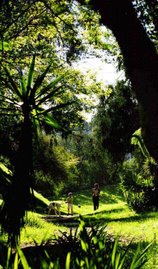 Photo: Diane Edwardson, October 1, 2009. Poison Oak still blooming on the 18-Acre Elysian Park Parcel off Riverside Drive. (Click on photo to enlarge.)
Photo: Diane Edwardson, October 1, 2009. Poison Oak still blooming on the 18-Acre Elysian Park Parcel off Riverside Drive. (Click on photo to enlarge.)UPDATE 10-5-09: This post contained misguided information on the rash caused by Poison Oak. We regret any confusion this may have caused. Click here for more information.
A big clump of dark green Poison Oak (Toxicodendron diversilobum) is still blooming about 10 yards away from the patch of Poison Oak in yesterday's post. The difference is the dark green patch is in full sun for much of the day. The patches at the base of the slope have limited sun and have already begun turning red before they drop their leaves for winter.
Poison Oak can cause severe dermatitis. The leaves and stalks have an oily substance that can cause blisters and in some people, severe allergic reactions.
Poison Oak, a native plant, thrives on the wooded slopes in Elysian Park, Griffith Park and the Menlo Property, but not on the Red Car Property. I'll speculate they simply removed so much earth from the Red Car Property when they built the 2 & 5 Freeways, that Poison Oak did not recolonize the slopes as California Black Walnuts did.


